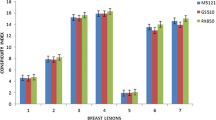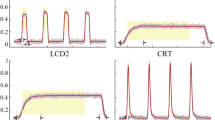Abstract
Liquid crystal display (LCD) monitors show a homogenous quadratic pattern in the number of pixels, size, and dimensions. However, their modulation transfer function (MTF) has a non-isotropic effect in the vertical, horizontal, and diagonal directions on the screen from the shape and pattern of arrangement of pixels. Moreover, the MTF of the human eye differs in spatial frequency response directivity among individuals. In this study, the high-brightness LCD monitor detectability was physically simulated and visually examined throughout the system, including the imaging system. Furthermore, the influence of anisotropy of the LCD monitor was evaluated. The MTF of the LCD monitor was measured by acquiring a bar pattern using a digital camera with sufficiently small pixels in the vertical, horizontal, and diagonal directions and by performing interpolation processing through waveform reproduction and frequency analysis. The detectability of the LCD monitor was verified throughout the system, including the imaging system. Radiographs of the rectangular wave chart (0.5–10 LP/mm) were obtained in the vertical, horizontal, and diagonal (45°) directions to assess the perceivable limit of the human eye (LP/mm). The spatial resolution of the LCD monitor in the diagonal direction was higher than that in the vertical or horizontal direction, which was in good agreement with the results of the profile analysis and visual evaluation.





Similar content being viewed by others
References
Kundel HL, Polansky M, Dalinka MK, Choplin RH, Gefter WB, Kneelend JB, Miller WT (2001) Reliability of soft-copy versus hard-copy interpretation of emergency department radiographs: a prototype study. Am J Roentgenol 177(3):525–528
Nishikawa RM, Acharyya S, Gatsonis C, Pisano ED, Cole EB, Marques HS, D’Orsi CJ, Farria DM, Kanal KM, Mahoney MC, Rebner M, Staiger MJ, For the Digital Mammography Image Screening Trial investigator group (2009) Comparison of soft-copy and hard-copy reading for full-field digital mammography. Radiology 251(1): 41–49
Hue JE, Rosenfield M, Saá G (2014) Reading from electronic devices versus hardcopy text. Work 47(3):303–307
Arenson RL, Chakraborty DP, Seshadri SB, Kundel HL (2003) The Digital Imaging Workstation. J Digit Imaging 16(1):142–162
Tabatabaei MS, Langarizadeh M, Tavakol K (2017) An Evaluation Protocol for Picture Archiving and Communication System: a Systematic Review. Acta Inform Med 25(4):250–253
Doi K (1985) Basic imaging properties in radiographic systems and their measurements, in Orton C (ed): Progress in Medical Radiation Physics (ed 11). New York, NY, Plenum 181–248
Kim TH, Lee YW, Cho HM, Lee IW (1999) Evaluation of image quality of color liquid cristal displays by measuring modulation transfer function. Opt Eng 38(10):1671–1678
Ichikawa K, Hasegawa M, Kimura N, Kodera Y (2008) A new resolution enhancement technology using the independent sub-pixel driving for the medical liquid crystal displays. IEEE/OSA J Display Technol 4(4):377–382
Watanabe A, Mori T, Nagata S, Hiwatashi K (1968) Spatial sine-wave responses of the human visual system. vision Res 8(9): 1245–1263
Chawla AS, Rodriguez JJ, Roehrig H, Fan J (2005) Determining the MTF of Medical Imaging Displays Using Edge Techniques. J Digit imaging 18(4):296–310
Shiraishi J, Abe H, Ichikawa K, Schmidt RA, Doi K (2010) Observer study for evaluating potential utility of a super-high-resolution LCD in the detection of clustered microcalcifications on digital mammograms. J Digit imaging 23(2):161–169
Yamazaki A, Wu CL, Cheng WC, Badano A (2013) Spatial resolution and noise in organic light-emitting diode displays for medical imaging applications. Opt Express 21(23):28111–28133 ()
Digital Imaging and Communication in Medicine. DICOM PS3.14 2014-Greyscale Standard Display Function (2014) NEMA
Sabet FA, Raeisi NA, Hamed E, Jasiuk I (2016) Modelling of bone fracture and strength at different length scales: a review. Interface Focus 6(1):20150055
Funding
There is no source of funding.
Author information
Authors and Affiliations
Corresponding author
Ethics declarations
Conflict of interest
All authors declare that they have no conflict of interest.
Additional information
Publisher's Note
Springer Nature remains neutral with regard to jurisdictional claims in published maps and institutional affiliations.
Rights and permissions
About this article
Cite this article
Niimi, T., Mano, A., Sobue, R. et al. Detectability of the diagonal direction in the assessment of medical images using a high-brightness liquid crystal display monitor. Phys Eng Sci Med 44, 117–122 (2021). https://doi.org/10.1007/s13246-020-00959-z
Received:
Accepted:
Published:
Issue Date:
DOI: https://doi.org/10.1007/s13246-020-00959-z




